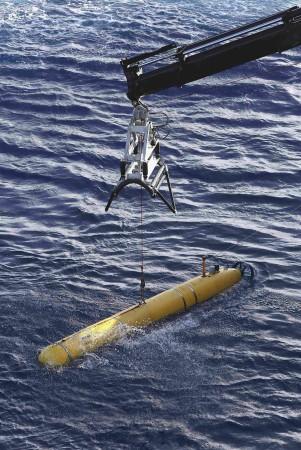
The area where acoustic signals or 'pings' thought to have been linked to the missing Malaysian Flight MH370 were detected, has now been ruled out as the final resting place of the aircraft, Australian officials say.
The Bluefin-21 submersible robot – used to scale through every inch of the ocean floor – had finished its search within the stipulated area and found nothing, they say.
This comes after four pings that officials believed could be from the missing MH370's "black box" flight recorders were heard last month by search teams using a towed pinger locator device. Those pings were used to determine the area for the sea-floor search, conducted by the Bluefin-21 robot.
"Yesterday afternoon, Bluefin-21 completed its last mission searching the remaining areas in the vicinity of the acoustic signals detected in early April by the towed pinger locator," the Joint Agency Co-ordination Centre (JACC) said in a statement.
"The data collected on yesterday's mission has been analysed. As a result, the JACC can advise that no signs of aircraft debris have been found by the autonomous underwater vehicle since it joined the search effort.
"The Australian Transport Safety Bureau (ATSB) has advised that the search in the vicinity of the acoustic detections can now be considered complete and in its professional judgement, the area can now be discounted as the final resting place of MH370."
The statement comes weeks after it was claimed that the acoustic signals most probably came from man-made sources.
Earlier in the month, an archeologist claimed he does not believe that the pings heard by pinger locators aboard vessels looking for the missing Malaysia Airlines jet MH370, could actually be from the plane's black box, as earlier thought.
William Meacher, who is part of the University of Hong Kong, said there are hundreds of marine animals fitted with detectors as their movements are tracked across the world.
The latest statement from the search team also comes hours after a US Navy official told CNN that the 'pings' likely came within the electronics of the robot.
"Our best theory at this point is that [the pings were] likely some sound produced by the ship... or within the electronics of the towed pinger locator," Michael Dean, the US Navy's deputy director of ocean engineering, told the US broadcaster.
"Always your fear any time you put electronic equipment in the water is that if any water gets in and grounds or shorts something out, that you could start producing sound," Dean said.
His claims were, however later described by a US Navy spokesman as "speculative and premature".
The Malaysian airline flight has now been widely referred to as just 'MH370' due to the enormous amount of global attention it has gathered. The ill-fated aircraft simply vanished into thin air just one hour into its journey from Kuala Lumpur to Beijing in the wee hours of 8 March.
A massive team of international searchers have not been able to find any debris from the aircraft, three months after the plane went missing. Many people have claimed to have seen possible plane in the waters, including people from Maldives, an oil rig worker who saw a plane in flames, and an Australian man who saw a possible submerged aircraft in the Indian Ocean near Bali, Indonesia.

















